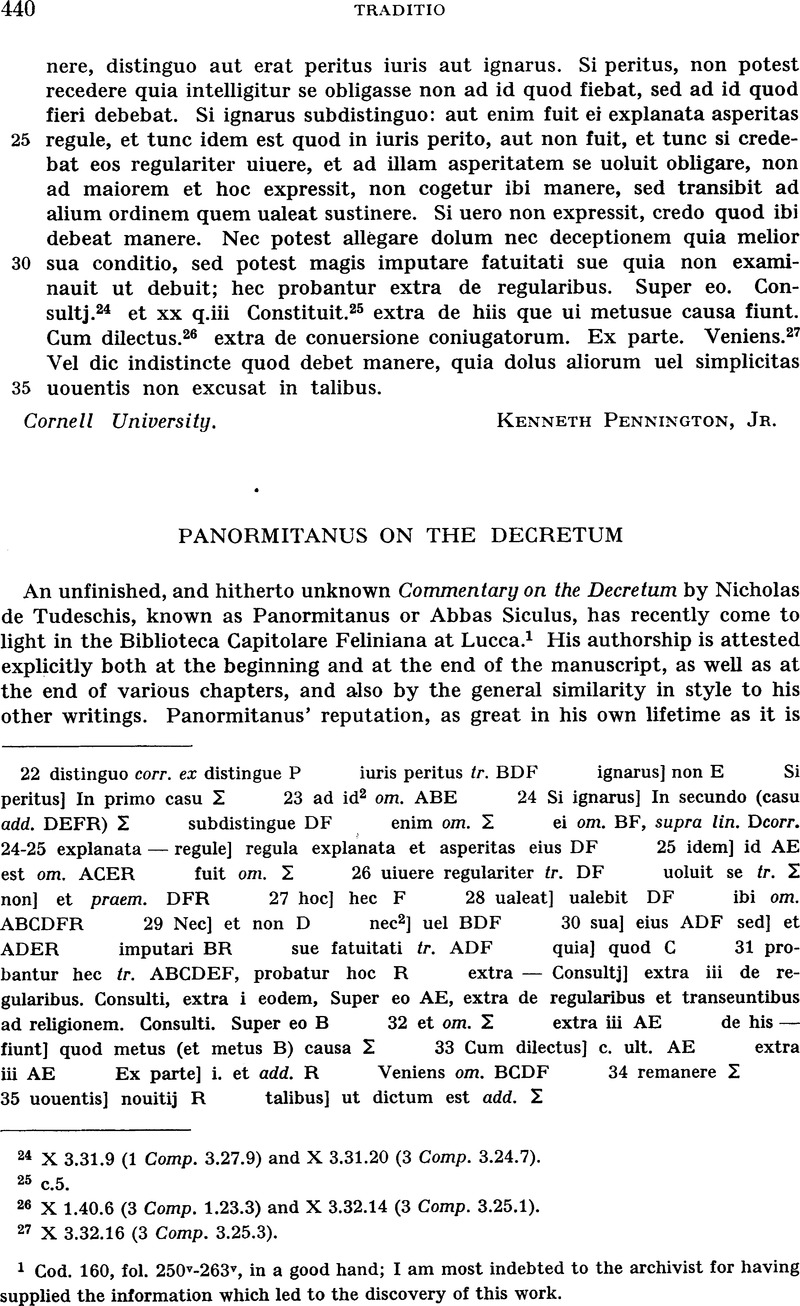Article contents
Panormitanus on the Decretum
Published online by Cambridge University Press: 29 July 2016
Abstract

- Type
- Institute of Medieval Canon Law: Bulletin for 1970
- Information
- Copyright
- Copyright © Fordham University Press
References
1 Cod. 160, fol. 250v–263v, in a good hand; I am most indebted to the archivist for having supplied the information which led to the discovery of this work.Google Scholar
2 Cf. DDC 6 (Paris 1957) 1195–1215, by Lefebvre, C.; Nörr, K., Kirche und Konzil bei Nicholas de Tudeschis (Forschungen zur kirchlichen Rechtsgeschichte und zum Kirchenrecht 4; Köln-Graz 1964); Lefebvre, C., ‘L'enseignement de Nicholas de Tudeschis et l'autorité pontificale,’ Ephemerides iuris canonici 14 (1958) 312ff.; also Schweizer, J., Nicolaus de'Tudeschi …: Seine Tätigkeit am Basler Konzil (Strasbourg 1924).Google Scholar
3 Sandeus, Felinus, Commentaria in V lib. Decretalium (Venice 1570), I 365 n. 44, on X 1.3.2: ‘firmat etiam Abb. in proemio ad commentum quod incipit Basilicae (sic) super Decreto’: from the observation of S. Kuttner noted by Lefebvre, art. cit. 313 n. 6; Gesner, C., Bibliotheca universalis (Froschoveri 1545), fol. 532v, followed by Mongitore, A., Bibliotheca Sicula II (Palermo 1714) 102: ‘Commentum inchoatum in Decretum, ex Gesnero cit., sed numquam se vidisse fatetur Bellarminus’. The work is mentioned by Lefebvre loc. cit. and DDC 6.1203.Google Scholar
4 British Museum, IC 34425 (Pisa 1485?): it is also included in editions of Felinus Sandeus, Super titulo de rescriptis et nonnullis aliis : Hain, L., Repertorium bibliographicum nos. 14301, 14303, 14304, 14306; also in Sandeus, , Commentaria in V lib. Decretalium (Venice 1570) III 1159–84. On Sandeus, cf. Hilling, N., ‘Felinus Sandeus, Auditor der Rota,’ AKKR 84 (1904) 94ff.; his Commentary was also printed at Basel, 1567.Google Scholar
5 Super Decreto, Lucca MS 160 fol. 250v; the date previously given was 1436–7: DDC 6.1202.Google Scholar
6 Loc.cit. ; cf. de Turrecremata, Joannes, Commentarium super toto Decreto (Venice 1578) I 1, for the same sentiment, that ‘nemo nascitur sibi soli,’ as a reason for undertaking this commentary.Google Scholar
7 Op.cit. fol. 253va, on D.1 c.1.Google Scholar
8 Op.cit. fol. 257va, on D.1 c.6.Google Scholar
9 Ibid. fol. 257va-b; cf. Aquinas, St. Thomas, Summa Theologiae 1a 2ae q. 94 a. 2, concl.Google Scholar
10 Cf. (Guido de Baysio), Archidiaconus, Rosarium (Venice 1495) on D.1 c.6.Google Scholar
11 Ibid. fol. 257r–261r, on D.1 c.6: ‘An lex naturalis contineat unum preceptum an plura’ (fol. 257vb–258vb); ‘(an) sit nobis necessaria aliqua lex humana’ (fol. 258vb–259ra); ‘(an) fuerit necessaria aliqua lex divina’ (fol. 259ra-va); ‘an lex divina sit una tantum vel plures’ (fol. 259va-b); ‘an omnes actus virtuosi sint de lege nature’ (fol. 259vb–260ra); ‘utrum lex nature sit una apud omnes’ (fol. 260ra-b); ‘an lex nature possit mutari’ (fol. 260rb-va); ‘utrum lex nature possit a corde hominum aboleri’ (fol. 260va-b); ‘an ipsa lex (eterna) sit omnibus nota’ (fol. 260vb–261ra). Cf. Summa Theologiae 1a2ae q. 91 a.3–4; q. 93 a.2; q. 94 a.2–6.Google Scholar
12 Ibid. fol. 259ra .Google Scholar
13 Ibid. fol. 259va .Google Scholar
14 Ibid. fol. 261ra .Google Scholar
15 Ibid. fol. 257v .Google Scholar
16 Gierke, O., Political Theories of the Middle Ages, trans. Maitland, F. (Boston 1958) 98.Google Scholar
17 Op.cit. fol. 251rb .Google Scholar
18 Ibid. fol. 261rb, on D.1 c.8; cf. fol. 257va, and also 263v, on D.1 c.12, where there is an inconclusive discussion on the claims of the Roman empire. On Bartolus, cf. Ullmann, W., Principles of Government and Politics in the Middle Ages (Cambridge 1961) 283–5; and id. ‘De Bartoli sententia: Concilium representat mentem populi,’ in Bartolus de Sassoferrato: Studia et documenta (Perugia 1961) II 703ff.Google Scholar
19 Op.cit. fol. 261rb .Google Scholar
20 Ibid. fol. 261rb-va, on D.1 c.8. Cf. Summa Theol. 1a 2ae q. 90 a.3, concl. ad 2m, ad 3m .Google Scholar
21 Ibid. fol. 261va; cf. ibid. fol. 261vb . cf. Aristotle, , Politics 1.1.Google Scholar
22 Ibid. fol. 254ra, on D.1 c.1.Google Scholar
23 Loc.cit.; cf. ibid. fol. 261r and 254v .Google Scholar
24 Ibid. fol. 254rb .Google Scholar
25 Ibid. fol. 258rb, on D.1 c.6.Google Scholar
26 Cf. DDC 6. 1209.Google Scholar
27 Op.cit. fol. 258rb .Google Scholar
28 Ibid. fol. 255va, on D.1 c.2. He could have had in mind Summa Theol. 1a 2ae q.96 a.4 concl.Google Scholar
29 Cf. Black, A. J., ‘The Political Ideas of Conciliarism and Papalism, 1430–1450,’ JEH 20 (1969) 47–50. — Other, minor points of interest in this fragment are: (1) He asserts that custom counts as law — another Thomist proposition — and deduces thus, ‘ex quo infero quod si compromittitur in aliquem ut pronuntiat secundum legem, secundum ius, quod non excluditur facultas iudicandi secundum consuetudinem scriptam vel non scriptam’ (fol. 253vb, on D.1 c.1). (2) After discussing the view, currently championed by the Hussites, that the validity of a judge depends ‘ex merito vite’; and calling attention to the Archdeacon in the same vein, he concludes with a somewhat ambiguous statement on the principle of ex officio validation: ‘ex officio suo, servata iudiciarii ordinis integritate’ (fol. 255rb, on D.1 c.2). (3) He discusses textual problems in considerable detail. He comments, on the rubrics of the Decretum, that they were composed either by Gratian ‘quod tamen non creditur,’ or by a disciple or someone else, which he thinks more likely (fol. 251vb, on D.1 § Supremus illud). This shows an awareness that historical study was relevant to problems of legal interpretation; and elsewhere he says, ‘nota … quod cronice sunt allegabiles’ (fol. 251r, on D.1 § Supremus illud).Google Scholar
- 1
- Cited by


